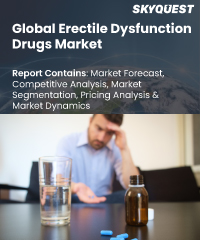
Report ID: SQMIG35I2259

Report ID:
SQMIG35I2259 |
Region:
Global |
Published Date: October, 2024
Pages:
157
|
Tables:
65 |
Figures:
75
Drivers
Increasing Prevalence of Erectile Dysfunction
Growing Aging Population
Restraints
Regulatory Challenges
Availability of Non-pharmaceutical Alternatives
Our industry expert will work with you to provide you with customized data in a short amount of time.
REQUEST FREE CUSTOMIZATIONErectile Dysfunction Drugs Market size was valued at USD 2.50 Billion in 2022 and is poised to grow from USD 2.71 Billion in 2023 to USD 5.21 Billion by 2031, at a CAGR of 8.50% during the forecast period (2024-2031).
The competitive landscape of the global erectile dysfunction drugs market is characterized by intense competition and a range of players striving to capture a significant market share. The market is highly dynamic, with multiple pharmaceutical companies and manufacturers vying to provide effective treatment options for erectile dysfunction. These players focus on research and development activities to develop innovative drugs and enhance existing formulations. Strategic alliances, collaborations, and partnerships with healthcare providers, research institutions, and distribution networks are common strategies employed to gain a competitive edge. Additionally, marketing initiatives, brand building, and extensive product promotion are crucial for market penetration and creating awareness among target consumers. The competitive landscape is further influenced by factors such as patent protections, regulatory approvals, pricing strategies, and the ability to address safety concerns associated with these drugs. The presence of generic alternatives also impacts competition and market dynamics. Overall, the global erectile dysfunction drugs market presents a competitive environment driven by innovation, strategic partnerships, and effective marketing strategies. 'Pfizer Inc. - United States', 'Eli Lilly and Company - United States', 'Bayer AG - Germany', 'Johnson & Johnson - United States', 'GSK (GlaxoSmithKline) - United Kingdom', 'Novartis International AG - Switzerland', 'Sanofi - France', 'AstraZeneca - United Kingdom', 'Boehringer Ingelheim - Germany', 'Teva Pharmaceutical Industries Ltd. - Israel', 'Mylan N.V. - United States', 'Endo International plc - Ireland', 'Amgen Inc. - United States', 'Bristol Myers Squibb - United States', 'AbbVie Inc. - United States', 'Actavis (now part of Teva Pharmaceutical Industries) - United States', 'GlaxoSmithKline Consumer Healthcare Ltd. - United Kingdom', 'Sun Pharmaceutical Industries Ltd. - India', 'Torrent Pharmaceuticals Ltd. - India', 'Cadila Healthcare Ltd. - India'
The rising prevalence of erectile dysfunction globally is a major driver for the market. Factors such as sedentary lifestyles, obesity, chronic diseases (diabetes, cardiovascular diseases), and aging contribute to the growing incidence of erectile dysfunction.
Rising Demand for Non-Oral Administration Routes: While oral medications (such as PDE5 inhibitors) have been the primary treatment option for erectile dysfunction, there is an increasing demand for alternative administration routes. This includes the development of topical creams, injections, and transdermal patches that offer localized and targeted treatment.
North America is the dominant region in the global erectile dysfunction drugs market, accounting for the largest market share in 2022. This is due to the fact that North America has a high prevalence of erectile dysfunction, a strong healthcare infrastructure, and a large number of patients who are willing to pay for erectile dysfunction drugs.
Want to customize this report? This report can be personalized according to your needs. Our analysts and industry experts will work directly with you to understand your requirements and provide you with customized data in a short amount of time. We offer $1000 worth of FREE customization at the time of purchase.

Report ID: SQMIG35I2259